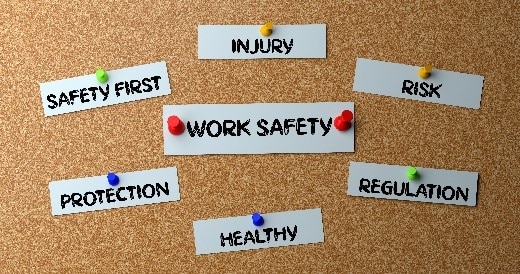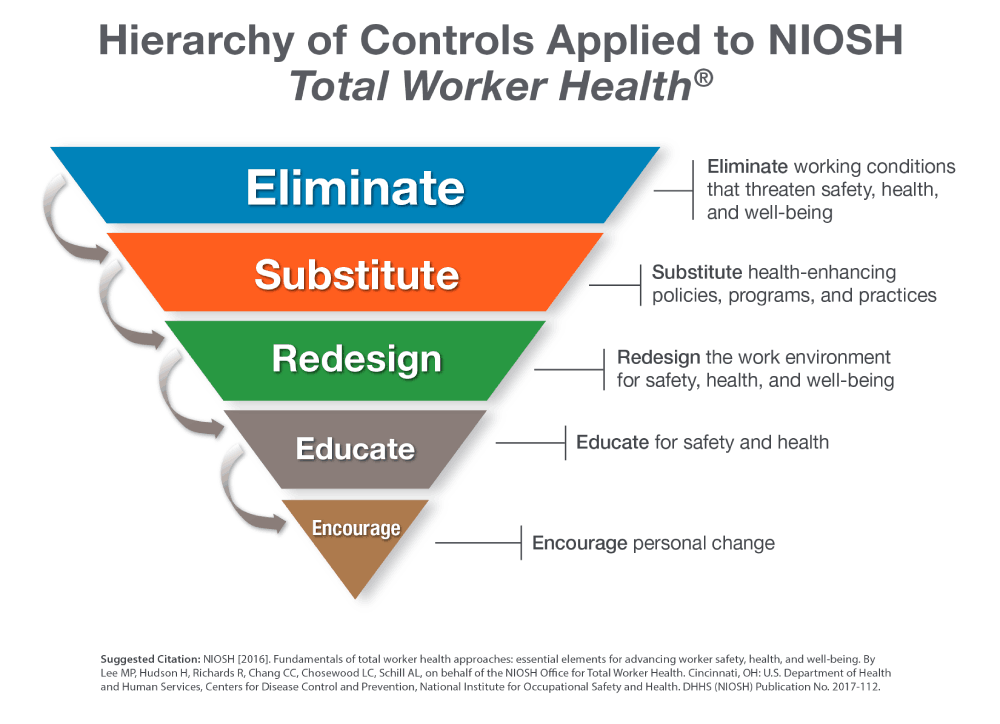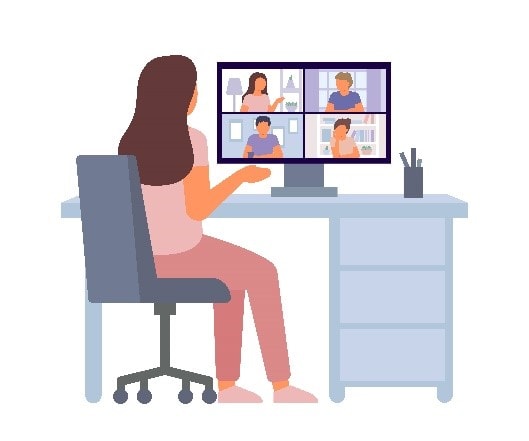Total Worker Health in Action: June 2021
Volume 10, Number 2, June 2021
Director’s Buzz
L. CASEY CHOSEWOOD, MD, MPH
During National Safety Month, the Total Worker Health (TWH) program emphasizes a fundamental aspect of the TWH approach: keeping workers safe. Implementing the TWH approach is an ongoing effort in which workers’ safety, health, and well-being are top priorities. In many settings, this consists of a mix of interventions, policy changes, and practices that create a robust culture of safety, worker protection, and greater health opportunity.

Putting this approach into action often starts with an organizational focus, assessing challenges to keeping workers safe. The TWH Exclusive in this issue describes how TWH strategies can help to create and sustain a safety culture, including a resource that organizations can use to assess and prioritize efforts. Once workplaces understand the benefits of this approach, then trainings such as those highlighted in this issue’s Promising Practice can assist in the implementation of integrated approaches. Establishing policies, programs, and practices in the workplace that focus on advancing the safety, health, and well-being of the workforce helps individuals, their families, communities, employers, and the economy. Find out how the NIOSH TWH Program is recognizing National Safety Month and get the latest news, like the save the date for the Third International Symposium to Advance Total Worker Health, below!
Total Worker Health Exclusive
Recognizing National Safety Month
Each June, the National Safety Council (NSC)external icon observes National Safety Monthexternal icon. The annual observance is intended to help keep workers safe, on and off the job. During the 25th anniversary of National Safety Month, the Total Worker Health program joins NSC in recognizing this important observance and highlights resources to improve the safety of workers everywhere.
National Safety Month begins with a focus on preventing incidents before they happen, by identifying risks and taking proactive measures to reduce hazard exposure. These steps are crucial to creating a safe workplace. Workplaces aligned with Total Worker Health (TWH) approaches also prioritize a hazard-free work environment for all workers.
The second week of National Safety Month emphasizes the important role employers play in addressing ongoing safety concerns related to the pandemic. Next, the final weeks of June focus on inclusive safety culture and continuous improvement of individual and organizational safety journeys. Organizations working to improve workplace safety or to sustain a culture of safety and health can refer to the Hierarchy of Controls Applied to NIOSH Total Worker Health®. This model is used to prioritize efforts to advance worker safety, health, and well-being.

The Hierarchy of Controls Applied to NIOSH TWH emphasizes organizational-level interventions to protect workers’ safety, health, and well-being. This companion to the traditional Hierarchy of Controls expands on the existing model to include strategies that advance worker well-being. Eliminating or reducing recognized hazards in the workplace is still placed at the top, because it is the most effective means of prevention.
Programs using a TWH approach should emphasize elimination or control of workplace safety and health hazards as the primary goal. Addressing environmental determinants of health rather than focusing on individual-level ones is crucial. To implement the hierarchy, workplaces should:
- Eliminate working conditions that threaten safety, health, and well-being. This includes any workplace conditions that cause or contribute to worker illness and injury or otherwise negatively impact well-being. For example, remove harmful supervisory practices throughout the management chain, if applicable.
- Replace unsafe, unhealthy working conditions or practices with safer, health-enhancing policies, programs, and management practices that improve the culture of safety and health in the workplace.
- Redesign the work environment, as needed, for improved safety, health, and well-being. Examples include removing barriers to improving well-being, enhancing access to employer-sponsored benefits, and providing more flexible work schedules.
- Educate workers by providing safety and health education and resources to enhance individual knowledge for all.
- Encourage personal behavior change to improve safety, health, and well-being. Assist workers with individual risks and challenges, while providing support in making healthier choices.
The TWH approach can be used by organizations year-round to create and sustain a culture of safety and health. During National Safety Month, learn more about why keeping workers safe is fundamental and find examples of how the Hierarchy of Controls Applied to NIOSH TWH can be used to improve the safety, health, and well-being of workers.
L. Casey Chosewood, MD, MPH, Executive Editor
Emily Norton, Managing Editor
Sarah Mitchell, Associate Editor
Seleen Collins, Copy Editor
Matt Osborne, NIOSH Web Developer
Steve Leonard, NIOSH Web Publisher
Please send your comments and suggestions to us at twh@cdc.gov.
To receive the NIOSH TWH email newsletter, enter your email address:
Promising Practice
Editor’s Note: The NIOSH Total Worker Health program developed this article in collaboration with Dede Montgomery, MS, CIH, Outreach Core Co-Director, Oregon Healthy Workforce Center, montgomd@ohsu.edu.
Oregon Total Worker Health Alliance: Advancing TWH Professional Training
In a 2019 issue of TWH in Action!, the Oregon Healthy Workforce Centerexternal icon (OHWC) reported on the launch of the Total Worker Health® training curriculum. Over the past 18 months, the Oregon Total Worker Health Alliancepdf iconexternal icon worked to adapt existing courses to a virtual format and to successfully train professionals and organizations in Total Worker Health (TWH) approaches.
Currently the most active initiative involving this Alliance, the TWH training curriculum aims to provide consistent, reproducible training that is evidence-based and supportive of organizational practices. The training is designed for occupational safety and health, worker compensation, risk management, wellness, and human resource practitioners and professionals. While the NIOSH Fundamentals of Total Worker Health® Approachespdf icon continue to be a key primer for this training, workplace case studies were recently added.

Prior to the pandemic, all courses were taught live, often in conjunction with partner events and conferences. The pandemic interrupted face-to-face training, encouraging the consideration of alternative virtual formats. The Alliance adapted the 3-hour course “Total Worker Health 101: The Basics” into an online course and delivered it at OHWC’s Occupational Health Psychology Summer external iconInstituteexternal icon in July 2020. Since then, the Alliance has delivered online courses at regional chapter meetings and newly scheduled professional development courses of the American Society of Safety Professionals (ASSP). Cementing the success of the TWH practitioner trainings, the Alliance assisted ASSP chapter contacts to obtain ASSP continuing education credits for the 3-hour classes. Chapters sponsoring this class as a professional development course so far include Columbia-Willamette, Broken Top, and Southern Oregon (all in Oregon); Sacramento and Greater San Jose (California); and Lower Columbia Basin (Washington). Because the course is held virtually, individuals who may not have been able to travel even prior to the pandemic are able to attend.
Another popular offering is a 1-hour course, “What Occupational Safety and Health Professionals Need to Know About TWH,” geared toward occupational safety and health (OSH) professionals. Though originally intended for audiences within the region, this short course was presented to an ASSP chapter in Florida and at ASSP’s Safety FOCUS 2020. The 3-hour and 1-hour courses were also provided to members of the Association of Occupational Health Professionals in Healthcare (AOHP), American Industrial Hygiene Association (AIHA), and American Association of Occupational Health Nurses (AAOHN).
With many OSH professional associations becoming NIOSH TWH Affiliates, there is growing demand for standardized training and follow-up conversations on how to implement the TWH approach. To support this need, the Alliance added a new feature this spring, a quarterly meet-up with “graduates” of the “TWH 101: The Basics” class. This 1-hour, small group informal discussion is an opportunity for course instructors to trade notes with attendees about new initiatives, successes, and resources. One key finding is that trainings and meet-ups are much richer when attended by individuals from diverse organizations, industries, and skill sets. Additional findings highlight the challenges posed by the pandemic, putting a spotlight on the relevance of the TWH approach.
Moving forward, a second half-day course called “Workplace Solutions” will make its virtual debut, as an addition to “TWH 101: The Basics,” to create a full-day professional development course at the AIHA 2021 Conference. The Alliance is also developing a virtual “Train the Trainer” course for TWH 101 graduates. Including those enrolled for the upcoming classes, over 300 individuals have taken the “TWH 101: The Basics” class since its launch in 2019. More than 100 individuals completed the “What OSH Professionals Need to Know about TWH” course. Stay tuned for more training developments from the Oregon TWH Allianceexternal icon or contact Dede Montgomery at montgomd@ohsu.edu if you are interested in learning more about training opportunities.
Spotlight on Opioids in the Workplace
Editor’s note: If you or someone you know needs assistance (in English or Spanish) with mental health concerns and/or substance use disorders, prevention, and recovery, please contact SAMHSA’s National Helpline at 1-800-662-HELP (4357) or visit https://www.samhsa.gov/find-helpexternal icon.

Addressing Opioid Overdose Deaths in the Workplace
NIOSH recently published a video called Addressing Opioid Overdose Deaths in the Workplace. This resource can help employers decide whether to have naloxone, an effective drug for reversing opioid overdoses, available in their workplace. The video also gives employers and workers information on how to implement and maintain a workplace naloxone program. To learn more, review the fact sheet Using Naloxone to Reverse Opioid Overdose in the Workplace: Information for Employers and Workers.
Prescription Opioid and Benzodiazepine Medications and Occupational Safety and Health: Information for Employers and Healthcare Providers
A new fact sheet summarizes findings from the scientific literature and provides information from relevant CDC and NIOSH publications for employers and healthcare providers about the prescription use of opioids and benzodiazepines. Some occupational factors, such as work-related motor vehicle crashes, falls, other injuries, and job stress, have the potential to increase the chances that a worker is given a prescription for an opioid or benzodiazepine.
News from NIOSH

NIOSH National Center for Productive Aging and Work Welcomes Dr. Gigi Petery
The NIOSH National Center for Productive Aging and Work is proud to welcome Gretchen (Gigi) A. Petery, PhD, who will support research and partnerships. Dr. Petery joins NIOSH from Curtin University in Perth, Western Australia, where she worked in the Future of Work Institute and the Centre for Transformative Work Design. Her graduate training was from the University of Connecticut in Industrial-Organizational Psychology, which applies psychology principles to the work environment, with an emphasis on occupational health psychology. She specializes in the aging workforce and has a broad knowledge of psychosocial workplace issues. Her research interests include factors that act as barriers to workforce participation and engagement, such as age bias and age meta-stereotypes (a person’s beliefs regarding the stereotype that out-group members hold about his/her own group). Welcome to Dr. Petery!
Free Webinar on The Role of Artificial Intelligence in the Future of Work
Join the NIOSH Future of Work Initiative on Thursday, June 17, 2021, from 1:00 to 2:00 pm Eastern for a free webinar, “The Role of Artificial Intelligence in the Future of Work.” This event, featuring Dr. Jay Vietas from NIOSH and Dr. Houshang Darabi from the University of Illinois–Chicago, will focus on how the application of artificial intelligence (AI) impacts the safety, health, and well-being of tomorrow’s workforce. Registration for this free event is required.
New Tool to Measure Worker Well-Being
NIOSH recently announced a new resource designed to measure worker well-being. The NIOSH Worker Well-Being Questionnaire (WellBQ) is a freely available survey instrument that provides an integrated assessment of worker well-being across multiple spheres. These include workers’ quality of working life, circumstances outside of work, and physical and mental health status. The questionnaire measures “worker” well-being as a holistic construct rather than simply “workplace” or “work-related” well-being. Contact the NIOSH TWH Program at TWH@cdc.gov if you have questions or would like more information.
Register for the June 3 Webinar “Workplace Health Disparities: A Total Worker Health Perspective”
Join the NIOSH Total Worker Health® Program for a closer look at workplace health disparities. The speakers will discuss the relationship between inequities, work, and health and will share strategies to address workplace health disparities. NIOSH speakers Constance Franklin and Michael Flynn will be joined by Dr. Kendra Jason from the University of North Carolina at Charlotte. Register todayexternal icon for the webinar, to be held on Thursday, June 3, from 2:00 to 3:30 pm Eastern. Free continuing education credit for this activity is pending.
Save the Date for the Third International Symposium to Advance Total Worker Health
The Center for Health, Work & Environment, Colorado School of Public Health, in collaboration with the NIOSH Office for Total Worker Health, is excited to announce the upcoming Third International Symposium to Advance Total Worker Health, to be held in 2022 (October 11–14). The Symposium will be held in person at the Natcher Conference Center, National Institutes of Health (NIH), Bethesda, Maryland, and online. The theme is Shaping Work, Now and in the Future, with the goals to Investigate (explore the latest, most compelling research that advances worker health, safety, and well-being around the globe), Connect (collaborate and share insights with investigators and practitioners using new methods and transdisciplinary approaches), and Apply (gain practical strategies to rapidly address existing and emerging issues so workers can thrive). Visit the NIOSH TWH Symposium webpage for the latest updates.
News from the NIOSH Centers of Excellence for TWH
- The Center for Health, Work & Environment (CHWE)external icon is launching a Workplace Mental Health Module to provide evidence-based training on what businesses can do to create a stronger culture that supports the mental health of all employees. The module offers a comprehensive online assessment, advising, and a report card that provides real-time results and recommendations. CHWE is also continuing the Health Links™ TWH webinar series with a webinar on June 16, 2021, called “Becoming an Antiracist Workplace.”external icon This webinar will help attendees create a shared understanding of what antiracist means, share tools for becoming antiracist individuals, and offer strategies for supporting antiracist work environments.
- The Center for the Promotion of Health in the New England Workplace (CPH-NEW)external icon offers virtual and online training programs to help professionals implement a TWH approach in the workplace. “Total Worker Health for OSH Professionalsexternal icon,” coming in summer 2021, is a self-paced, online continuing education course introducing TWH and how it applies to OSH professional practice. A 12-hour, 4-session program, “Remote Team Facilitation for Workplace Safety and Wellbeing,” teaches professionals how to use the Healthy Workplace Participatory Program materials to engage employees remotely. Learn more and register for the next cohort.external icon
- Investigators at the Harvard Center for Work, Health and Well-beingexternal icon are publishing various works to share research on integrated programs and initiatives aligned with the TWH approach. Two recent articles include Development and Application of an Innovative Instrument to Assess Work Environment Factors for Injury Prevention in the Food Service Industryexternal icon and Building Capacity for Implementation of Integrated Occupational Safety, Health, and Well-Being Initiatives Using Guidelines for Total Worker Healthexternal icon.
- The Healthier Workforce Center of the Midwest (HWC)external icon recently entered into an Alliance Agreementexternal icon with the Occupational Safety and Health Administration’s (OSHA) Federal Region VII to address behavioral health, which includes mental health and substance use, in the workplace. Learn more about the alliance in this news updateexternal icon. The HWC also released a new Workplace Mattersexternal icon podcast addressing Driving Safetyexternal icon and a new video demonstrating an active learning tool called Hazard Mappingexternal icon.
- The Oregon Healthy Workforce Center (OHWC)external icon published an article, “Looking for ways to support your employees? Start with work-life balanceexternal icon.” This quick read contains tips and resources on how organizations can better support workplace well-being. In honor of NIOSH’s 50th anniversary, OHWC also published a blogexternal icon highlighting the milestone. Stay tuned to their websiteexternal icon for a podcast release later this month featuring NIOSH Director Dr. John Howard, who will discuss NIOSH efforts over the past decades.
- The University of Illinois (UIC)–Center for Healthy Workexternal icon has a long-established partnership with the UIC Great Lakes Center for Occupational Safety and Health (GLC-OSH), a NIOSH-funded Education Research Center. The Center for Healthy Work sponsored a series of GLC-OHS Seminars in April 2021. View the recorded, hour-long webinarsexternal icon. The UIC Center for Healthy Work’s Outreach director, Dr. Christina Welter, was recently featured on the Health Promotion and Practice Podcastexternal icon hosted by Dr. Melissa Valerio. She discusses the Healthy Work Collaborative and policy, systems, and environmental change approaches to worker safety and health.
These are just a few of the updates from the NIOSH Centers of Excellence for TWH. To learn more about each of the Centers and their response efforts, visit their websites.
News from NIOSH TWH Affiliates and Partners
Featured Affiliates: Get to Know the NIOSH TWH Affiliates
This new feature was created to introduce our readers to the current NIOSH TWH Affiliates. See how two NIOSH TWH Affiliates responded when we asked about their work. If your organization is a NIOSH TWH Affiliate and is interested in being featured, please email TWH@cdc.gov.
AgriSafe Network
Learn more about the AgriSafeexternal icon!
University of North Carolina at Greensboro (UNCG) Workplace Health Network
Learn more about the UNCG Workplace Health Networkexternal icon!
Affiliate Updates
Calculate the Costs of Workplace Mental Distress
To help employers understand the pivotal role they play in supporting the mental health of their employees, the National Safety Council (NSC) and NORC at the University of Chicago created the Mental Health Cost Calculator for Employers. This authoritative, easy-to-use tool provides business leaders with data-driven insight about the costs of employee mental distress in their workplaces. Access the calculatorexternal icon and learn more about supporting employee mental healthexternal icon from NSC.
Call for Abstracts: Ex4OSH 2021 International Conference
The Ex4OSH 2021 International Conferenceexternal icon, brought to you by the Southwest Center for Occupational and Environmental Health at UTHealth School of Public Health (Houston, Texas), NIOSH, and the Conference Planning and Scientific Committee, is scheduled for December 9–11, 2021. Abstract submissions are being accepted until Friday, June 18, 2021. Learn more in the call for abstractsexternal icon.
Call for Poster Proposals: Work, Stress, and Health 2021 Virtual Conference
The Work, Stress, and Health (WSH) 2021 Virtual Conference will include a series of online events throughout the remainder of the year, including keynote and plenary sessions, posters, select curated paper sessions highlighting new developments in key topic areas, and networking events. WSH 2021 is now accepting proposals for poster presentations on a range of topics that address the changing nature of work and implications for worker safety, health, and well-being. Proposals are due Monday, June 7, 2021. Learn more in the call for proposalsexternal icon.
Mental Health America Finds Most Employees Experiencing Signs of Burnout
Mental Health America recently released the Mind the Workplace 2021 Reportexternal icon to better understand the mental health challenges that employees across company sizes and industries are experiencing. Data in the report come from the Work Health Surveyexternal icon, which measured the perceptions of 5,030 employees across 17 industries in the United States between February 13 and September 9, 2020. Survey questions measured financial insecurity, burnout, supervisor support, workplace stress, and mental illness. Two major takeaways from the report are that most employees are experiencing signs of burnout and employees are not receiving the support they need to manage stress.
Occupational Injury and Illness in New Hampshire
A new reportpdf iconexternal icon from the New Hampshire Occupational Health Surveillance Program (OHSP) explores New Hampshire’s work-related health factors such as illness, injuries, exposures, hazards, and interventions. Some of the major findings are highlighted. This report marks an important step on the path to a safer and healthier work environment for New Hampshire workers.
Occupational Injury and Fatalities in Kentucky
The Kentucky Fatality Assessment and Control Evaluation (FACE) Program is means of occupational fatality surveillance for the Kentucky Injury Prevention and Research Center (KIPRC). The Kentucky FACE Program has released its 2019 Annual Reportpdf iconexternal icon. You can also get a close look at occupational health indicators in Kentucky in this 2018 reportpdf iconexternal icon and visit the Kentucky Injury Prevention & Research Center Resources Libraryexternal icon for further information.
SAIF Leaderships Series
Training is available through the SAIF Leadership Seriesexternal icon, designed to help leaders at all levels learn the building blocks that support safety culture and boost employee involvement. The modules on supportive supervision include downloadable materials and a way to track supportive behaviors.
Workers’ Perspectives for Incorporating AI into Office Workspaces
University of Southern California Center for Intelligent Environments (CENTIENTS) published research about workers’ perspectives for incorporating Artificial Intelligence (AI) into office workspaces, exploring the implications for the future of office work. The article is in a special issue, “Worker Safety, Health and Well-being in the USAexternal icon,” of the International Journal of Environmental Research and Public Health.
To learn more about the Total Worker Health Affiliate program, visit https://www.cdc.gov/niosh/twh/affiliate.html.
New Publications and Resources
From CDC and NIOSH
Certificates, Degrees, and Graduate Training
New Model Looks Beyond the Workplace for Influences on Worker Safety and Health
New Publications and Resources from NIOSH Centers of Excellence for Total Worker Health
Changes in Precarious Employment in the United States: A Longitudinal Analysisexternal icon
Development and Validation of a Diabetes Risk Score Among Two Populationsexternal icon
Environmental Metal Exposures and Kidney Function of Guatemalan Sugarcane Workersexternal icon
Evaluation of a Total Worker Health Leadership Development Program for Small Businessexternal icon
International Total Worker Health: Applicability to Agribusiness in Latin Americaexternal icon
Sedentary Work and Physiological Markers of Healthexternal icon
Urine Tungsten and Chronic Kidney Disease in Rural Coloradoexternal icon
Conferences, Webinars, and Training in Support of NIOSH Total Worker Health
June
3 — The NIOSH TWH Webinar series presents “Workplace Health Disparities: A Total Worker Health Perspective” from 2:00 to 3:30 pm Eastern. Register todayexternal icon for this free webinar. Free continuing education for this activity is pending.
16 — The Center for Health, Work & Environment is continuing the Health Links™ TWH webinar series with “Becoming an Antiracist Workplace”external icon at 11:00 am Mountain (1:00 pm Eastern). This webinar will help attendees create a shared understanding of what antiracist means, share tools for becoming antiracist individuals, and offer strategies for supporting antiracist work environments.
21 — Chia-Chia Chang, Coordinator for Partnership and New Opportunity Development, will present “Integrated Approach to Employee Safety, Health, and Well-Being” at the Serviço Social da Indústria (SESI)external icon conference.
22 — Chia-Chia Chang will present “The Future of Worker Safety and Health: Challenges and Opportunities” at the International Stress Management Association–Brazilexternal icon conference.
July
27 — The Oregon Healthy Workforce Center’s (OHWC) YourWorkpath Programexternal icon continues to offer monthly drop-in sessions for the “YourWorkpath: Toolkit and Tools Tour.”external icon Join OHWC Dissemination Specialist Helen Schuckers to learn about workplace safety, health, and well-being resources and take a tour of the dissemination website. These virtual drop-in tours are the last Tuesday of each month at 9:00 am Pacific (12:00 pm Eastern). Please register in advanceexternal icon.
28–29 — Chia-Chia Chang, Coordinator for Partnership and New Opportunity Development, will present “Worker Well-Being: The ‘What’ and the ‘How’” at the 2021 National Wellness Conferenceexternal icon, hosted by the National Wellness Institute.
Find more events on the NIOSH Conferences, Meetings, Webinars, and Events webpage.
This newsletter is published quarterly via email by the National Institute for Occupational Safety and Health Total Worker Health® Program to inform members of the public health community as well as interested members of the general public of program-related news, new publications, and updates on existing activities and initiatives.
Mention of any company or product does not constitute endorsement by the National Institute for Occupational Safety and Health, Centers for Disease Control and Prevention. In addition, citations to websites external to NIOSH do not constitute NIOSH endorsement of the sponsoring organizations or their programs or products. Furthermore, NIOSH is not responsible for the content of these websites. All web addresses referenced in this document were accessible as of the publication date.

